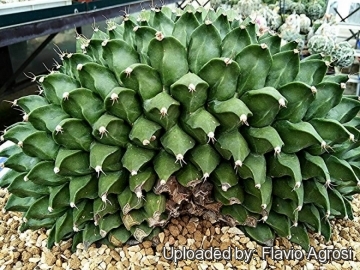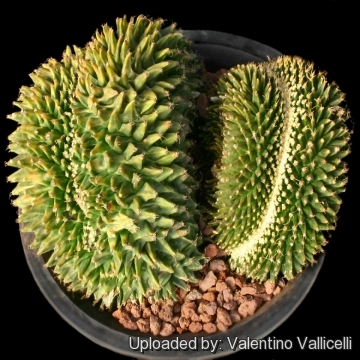
Obregonia denegrii f. cristata Photo by: Flavio Agrosi
Origin and Habitat: Garden origin
Synonyms:
See all synonyms of Obregonia denegrii
Description: Obregonia denegriiSN|2100]]SN|2100]] f. cristata (crested form), only deviate from the standard species for the stem which is fan shaped up to 30 cm (or more) long with age.
The typical Obregonia denegriiSN|2100]]SN|2100]] (commonly known as the "artichoke cactus") is among the most famous of all cacti for is unique shaped stem. It grows almost always as a solitary plant levelled with the ground, with the sunk and woolly apex. It is considered an intermediate form between Ariocarpus and Lophophora.
Stem: Solitary, greyish green to dark green, fan-shaped with a woolly linear meristematic apex, it grows up to 30 (or more) cm in width and ap to 15 cm thick.
Tubercles: Not imbricate, deeply cut like an artichoke, triangular, prominent, leaf like, flat above, keeled below and with a basal ridge.
Areoles: Small at the tips of the tubercles, with wool when young.
Spines: 2 to 4 whitish to brown about 5 to 15 mm long in the young tubercles, ± soft flexible, slightly curved and often rapidly shedding.
Roots: Thick taproot.
Flowers: The flowers grow between the wool of the apex, in the centre of the stem on young tubercles, they are funnel-shaped white diurnal, up to 2.5 cm in diameter, 2.5-3 cm long. External perianth segments greyish, pericarpel naked or with few scales. Filaments reddish purple or pink, anthers yellow, style white and stigma lobes white.
Blooming season: Summer.
Fruits: Hidden in the wool, pear-shaped, white naked, fleshy and edible that dry when mature. The withered flowers remaining attached.
Seeds: Large and black 1 to 1,4 mm long.
Bibliography: Major references and further lectures
1) Edward Anderson “The Cactus family” Timber Press, Incorporated, 2001
2) James Cullen, Sabina G. Knees, H. Suzanne Cubey "The European Garden Flora Flowering Plants: A Manual for the Identification of Plants Cultivated in Europe, Both Out-of-Doors and Under Glass" Cambridge University Press, 11/Aug/2011
3) David R Hunt; Nigel P Taylor; Graham Charles; International Cactaceae Systematics Group. "The New Cactus Lexicon" dh books, 2006
4) N. L. Britton, J. N. Rose “The Cactaceae. Descriptions and Illustrations of Plants of the Cactus Family.” Volume 4, The Carnegie Institution of Washington, Washington 1923, page. 41
5) Curt Backeberg “Die Cactaceae: Handbuch der Kakteenkunde” Gustav Fischer Verlag, Stuttgart New York 1982–1985
 Obregonia denegrii f. cristata Photo by: Cactus Art
Obregonia denegrii f. cristata Photo by: Cactus Art Obregonia denegrii f. cristata Photo by: Flavio Agrosi
Obregonia denegrii f. cristata Photo by: Flavio Agrosi Obregonia denegrii f. cristata Photo by: Flavio Agrosi
Obregonia denegrii f. cristata Photo by: Flavio Agrosi Obregonia denegrii f. cristata Photo by: Valentino Vallicelli
Obregonia denegrii f. cristata Photo by: Valentino VallicelliCultivation and Propagation: Although regarded as a choice and difficult plant is not too difficult in a greenhouse, although grows quite slowly. It is sometime seen as a grafted plant but grows very well on its own roots too.
Soil: Use mineral well permeable mineral soil with little organic matter (peat, humus).
Exposure: They need a good amount of light shade to full sun this help to keep the plants healthy, although slow growth.
Watering: Water sparingly from March till October (weekly during summertime, if the weather is sunny enough) , with a little fertilizer added. Less or no water during cold winter months, or when night temperatures remain below 10° to prevent root loss. It is sensitive to overwatering (rot prone).
Fertilization: Feeding may not be necessary at all if the compost is fresh then, feed in summer only if the plant hasn't been repotted recently. Do not feed the plants from September onwards as this can cause lush growth which can be fatal during the darker cold months.
Hardiness: Keep perfectly dry in winter at temperatures from 5 to 15 degrees centigrade. (but it is relatively cold resistant and hardy to -5° C, or possibly colder for short periods) In the rest period no high atmospheric humidity!! (Temperature Zone: USDA 9-11)
Crested growth: Unlike 'monstrose' varieties of plants, where the variation from normal growth is due to genetic mutation, crested growth can occur on normal plants. Sometimes it's due to variances in light intensity, or damage, but generally the causes are unknown. A crested plant may have some areas growing normally, and a cresting plant that looks like a brain, may revert to normal growth for no apparent reason. If you have any of the crested part left you need to remove the normal growth and leave the crested part behind this will need to be done regularly.
Propagation: Grafting or cuttings. Plants are usually grafted onto column-shaped cacti but proved to be able to produce their own roots if degrafted. Cuttings will take root in a minimum temperature of 20° C (but better in hot weather). Cuttings of healthy shoots can be taken in the spring and summer. Cut the stem with a sharp, sterile knife, leave the cutting in a warm, dry place for a week or weeks (depending on how thick the cutting is) until a callus forms over the wound. Once the callus forms, the cutting may be inserted in a container filled with firmed cactus potting mix topped with a surface layer of coarse grit. They should be placed in the coarse grit only; this prevents the cut end from becoming too wet and allows the roots to penetrate the rich compost underneath. Large crested piece must be placed on the soil surface without burying the plant base down in the soil. The application of both a rooting hormone as well as fungicide on the cut surfaces helps prevent infection and accelerate rooting.














